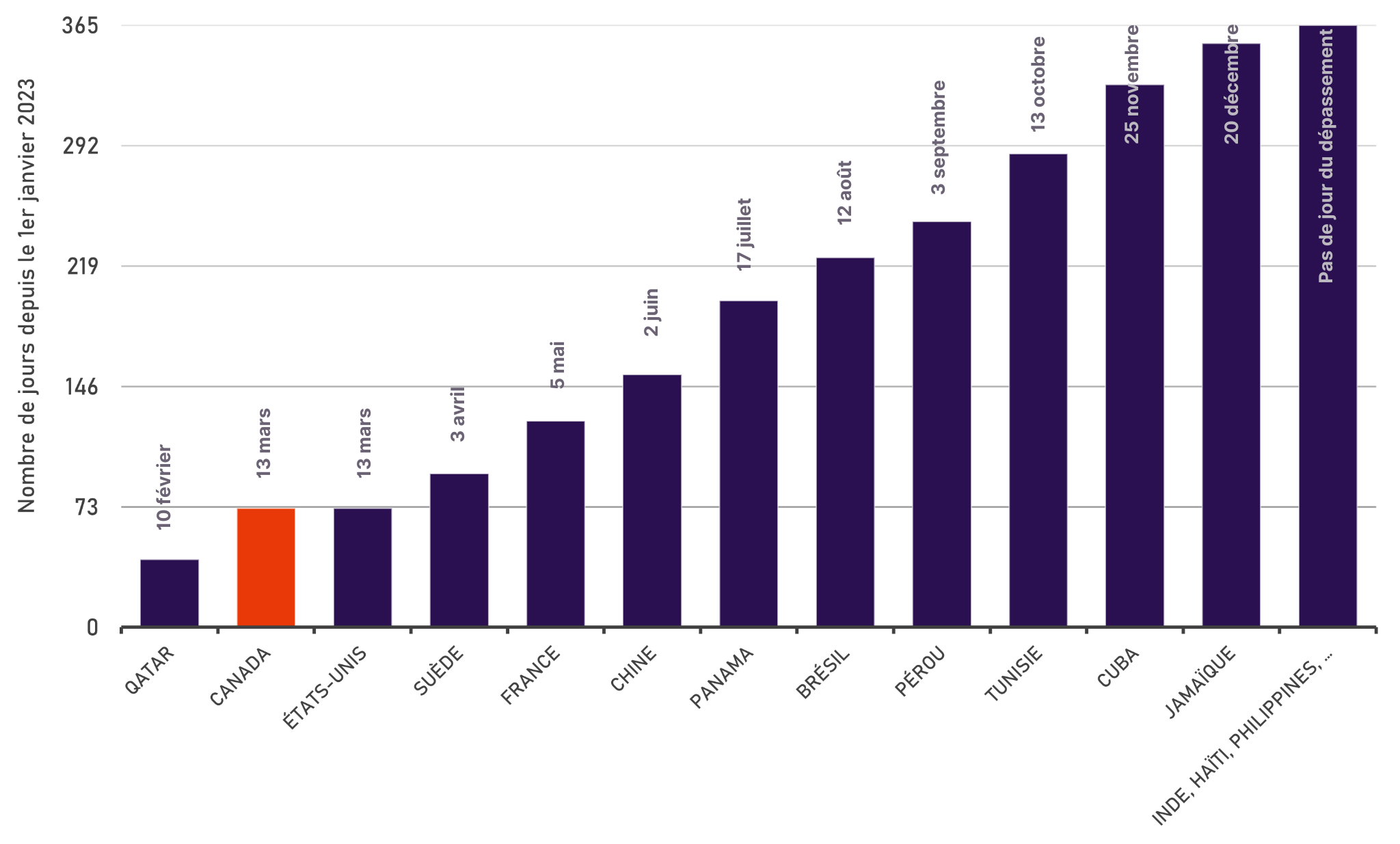Overtaking Day isn’t a race you want to finish first. In fact, in this annual race, you want to arrive as late as possible. Ideally, you shouldn’t even overtake…
What is Overshoot Day?
Developed by the research organization Global Footprint Network, Earth Overshoot Day is a concept that relates human consumption to the Earth’s capacity. More precisely, Earth Overshoot Day is the date on which demand for natural resources and ecological services over the course of a year exceeds the Earth’s annual regenerative capacity.
This year, the global exceedance day is August 2. This means that all the Earth’s capacity to regenerate during the year has been consumed between January 1 and August 2, 2023. For the rest of the year, humanity is in “ecological deficit”, i.e. we are using the natural resources of future generations to meet our present needs.
This results in a situation of imbalance due to excessive pressure on ecosystems, impoverishment of the ecological services provided by our planet, climate disruption and ocean acidification.
How is the overrun day calculated?
The calculation of the day of exceedance begins with a relationship between two elements: biocapacity and the global ecological footprint.
Firstly, biocapacity is the capacity of the Earth’s ecosystems to produce natural resources, such as wood, fruit and vegetables, fish and minerals, and to perform their ecosystem roles, such as absorbing CO2. Some places on Earth are more productive than others. Deserts, for example, are resource-poor, while tropical forests are rich and productive ecosystems. Thus, the Earth’s biocapacity is measured in terms of average productive surface area. This area has been estimated at 1.5 hectares per human being in 2023, equivalent to around 3 American soccer pitches.

Secondly, the global ecological footprint, for the purposes of calculating the day of overshoot, represents the area of productive land that one human would need to meet his or her demands. In 2023, this will amount to 2.6 hectares per human being, or almost 5 American soccer pitches. This report shows that the demand for resources and ecological services far exceeds what the Earth can produce per year.
Finally, to represent this gap in date form, the ratio between the two elements is multiplied by the number of days per year. Thus, this year, human demand would have exceeded the Earth’s regenerative capacity on the 214th day of the year, i.e. August 2, 2023.
Overshoot day by country in 2023
Not everyone contributes equally to the day of overshoot. To better illustrate this reality, the day of overshoot is calculated by country. In this context, the day of overshoot represents the day on which the Earth’s annual regeneration capacity would be exceeded if everyone on Earth consumed as much as the average person in that country.
Thus, an early date in the year indicates that the inhabitants of this country require a lot of resources to support their pace of life. The aim is therefore to arrive at the end of the race last; or never to arrive at all, as the 2023 champions: India, the Philippines, Haiti and many others.


Data source: Earth Overshoot Day
Unfortunately, Canada has a long way to go to join the champions. Like many other countries, it needs to do its part to delay its day of reckoning.
How can you postpone the day of overtaking?
The Global Footprint Network estimates that 60% of the surface area required per human being is dedicated to absorbing the carbon a person emits. In other words, 60% of the global ecological footprint is due to CO2 emissions. It is therefore imperative to reduce these emissions.
How do we go about it?
For companies
One way to reduce greenhouse gas (GHG) emissions is by choosing green energy. Indeed, according to the Global Footprint Network, if 75% of the world’s energy came from low-carbon sources, the day of the deadline could be postponed by 26 days! However, this change is not easy.
Will Solutions can help. As a carbon expert, Solutions Will is involved in this energy transition by remunerating your energy conversion or efficiency projects through the carbon credits they generate.
There are many other ways to reduce GHG emissions. All you need to do is know your climate impact with a carbon footprint. This tool enables you to identify which activities emit the most GHGs in order to prioritize reduction efforts.
For individuals
As a consumer, we can contribute to the delay of the day we pass by:
- adopting a lifestyle that encourages a lower rate of consumption
- encouraging the reuse and repair of goods.
- when consumption is necessary, choosing local and responsible companies.
By adopting such practices, the demand for natural resources and the pressure we place on ecological services and ecosystems will be lower. Demand will therefore be closer to the Earth’s regenerative capacity, and the date of the day of overshoot will be delayed.
In short, the day of overshoot illustrates very well the contrast between frenetic consumption, GHG emissions and the Earth’s limits. So, ironically, the lesson of the day of overshoot is to slow down…
#MoveTheDate


Anne Ménard
GHG auditor
Author of the article

